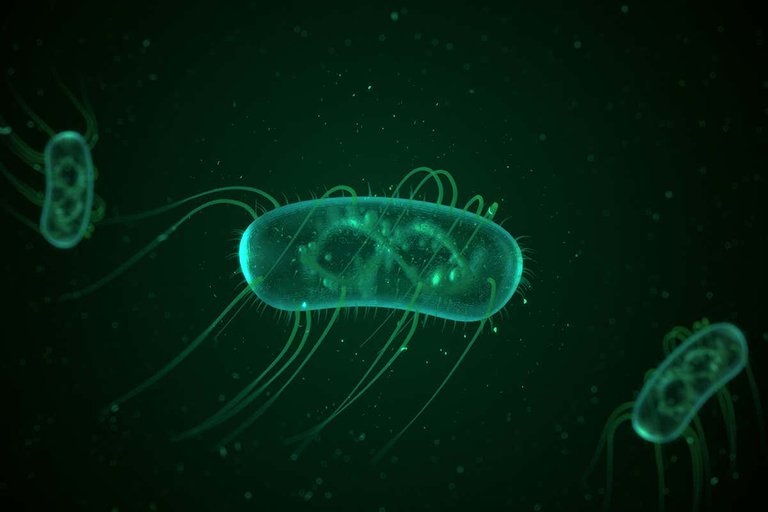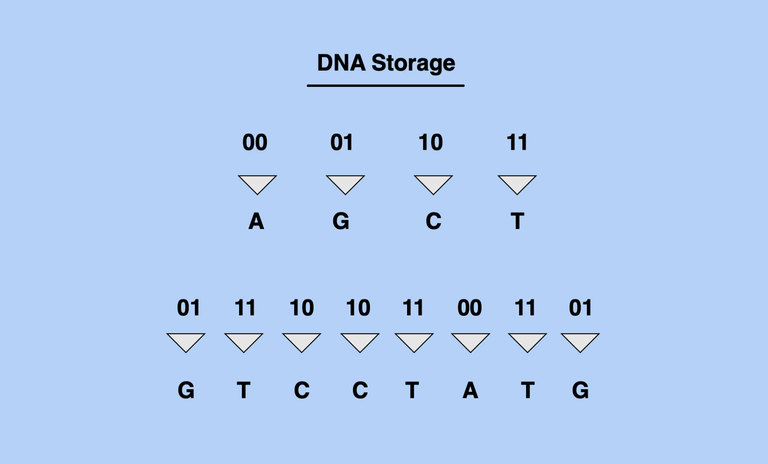
Source
As you all know, all living organisms have their operating instructions encoded in the nucleus of each of their cells, using for this the Deoxyribonucleic Acid (DNA) molecule and the 4 bases that form it (Cytosine, Adenine, Guanine and Thymine), these instructions are also passed down from generation to generation.
Como todos sabéis, todos los organismos vivos tienen sus instrucciones de funcionamiento codificadas en el núcleo cada una de sus células,
utilizando para ello la molécula de Acido Desoxirribonucléico(ADN) y las 4 bases que lo forman (Citosina Adenina, Guanina y Timina), estas instrucciones además se transmiten de generación en generación.
This DNA molecule capable of storing up to 10E15 bytes per gram and with great long-term stability make this molecule an ideal candidate for the storage of digital information that, from now on, can be done on living cells without having to create Synthetic DNA in vitro.
Esta molécula de ADN capaz de almacenar hasta 10E15 bytes por gramo y con una gran estabilidad a largo plazo hacen que esta molécula sea un candidato ideal para el almacenamiento de información digital que, a partir de ahora, podrá hacerse sobre células vivas sin tener que crear ADN sintético in vitro.
To achieve this, the scientists used an adapted version of the CRISPR-Cas9 system, a genetic editing tool that we have already talked about repeatedly in this medium, capable of locating specific DNA sequences and eliminating them or changing them for another sequence in something similar to copy / paste from Microsoft.
Para conseguir esto los científicos utilizaron una versión adaptada el sistema CRISPR-Cas9, herramienta de edición genética de la que ya hemos hablado en este medio repetidas veces, capaz de localizar secuencias concretas de ADN y eliminarlas o cambiarlas por otra secuencia en algo parecido al copy/paste de Microsoft.

Source
By applying an electrical current, the bacteria generate a large number of copies of DNA molecules separated from the chromosomes called plasmids, which CRISPR then inserts into the bacteria's DNA, which would be equivalent to "1" in binary system.
Aplicando una corriente eléctrica las bacterias generan un gran número de copias de moléculas de ADN separadas de los cromosomas llamadas plásmidos que luego CRISPR inserta en el ADN de la
bacteria, lo que equivaldría al "1" en sistema binario.
In the absence of current, as there is no excess of plasmids, CRISPR inserts a generic mark in the bacterial DNA that would be equivalent to "0", with which we already have a flip-flop with it that operations can be performed in the binary system just like a conventional computer.
En ausencia de corriente al no haber exceso de plásmidos CRISPR inserta una marca genérica en el ADN bacteriano que equivaldría al "0", con lo que ya tenemos un biestable con él que se pueden hacer operaciones en el sistema binario igual que una computadora convencional.

Source
Using this system they have managed to store up to 72 bits, which allowed them to encode and store the phrase "hello word!" what, after 80 cell divisions in which there were some mutations the message could be decoded with a reliability of 90%.
Utilizando este sistema se han conseguido almacenar hasta 72 bits, lo que les permitió codificar y almacenar la frase "hello word!" qué, después de 80 divisiones celulares en las que hubo algunas mutaciones el mensaje pudo descodificarse con una fiabilidad del 90%.
Obviously there is still a lot to investigate but, for the moment, they have already managed to store data in living organisms instead of having to synthesize DNA molecules in the laboratory, over time we will be able to use this system to be able to store huge amounts of data and, what's coolest, make molecular computers.
Obviamente todavía queda mucho que investigar pero, por el momento, ya han conseguido almacenar datos en organismos vivos en lugar de tener que sintetizar las moléculas de ADN en el laboratorio, con el tiempo seremos capaces de utilizar este sistema para poder almacenar cantidades ingentes de datos y, lo que mola más, fabricar computadoras moleculares.
More information/Más información
https://www.nature.com/articles/s41589-020-00711-4.epdf?sharing_token=cFreR6e_upDqjeZBFzSD-dRgN0jAjWel9jnR3ZoTv0N-JjfmyxypOzJwVIahUnWcXQLwwGoUd7YIixxJwvP53ranJwk3t4LoQ0yYtVtxBcENmVxxIdlYGcFS0mVbb3a4V-oyKKc4KIz-dWv6JHwoiaCtziceYjtXE1rIOipK_vYmNGGajIqkKfRaE_2hcj6L4FldiVrLZxgHMnDq3C7caKnk8hEBaT6RpIwaXTtpyXE%3D&tracking_referrer=www.newscientist.com
https://www.investigacionyciencia.es/noticias/logran-almacenar-datos-digitales-en-el-adn-de-bacterias-vivas-19437